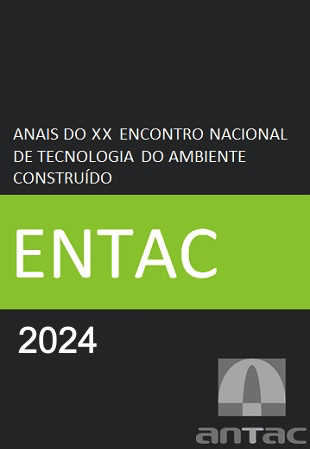Calibration of a computer simulation with a test cell composed with a wall thermosyphons
DOI:
https://doi.org/10.46421/entac.v20i1.6298Palavras-chave:
Calibration, EnergyPlus, Wall thermosyphons, Test cellResumo
Energy consumption is increasing exponentially. Studies indicate that the construction sector is one of the main contributors to such demands, and a significant portion of this consumption is dedicated to maintaining internal thermal comfort. Research indicates that irreversible global warming is underway until the end of this century. This emphasizes the dependence on mechanical climate control systems. In this context, passive cooling methods should be investigated. Thus, to broaden the investigation of these systems, the aim of this work is to calibrate a computational model, developed in the EnergyPlus software, with a test cell composed of a wall thermosyphon for internal cooling. The results from the first hour of IC and the last hour of Transient Condition were the ones that deviated the most from the calculated root mean square error limit for all simulated tests. These differences may be influenced by various factors, such as air infiltration into the test cell, system startup time, or even the thermophysical values of the materials used in the test cell envelope. In general, the data obtained in EnergyPlus were considered statistically equivalent to the experimental samples collected in the test cell, indicating, even with the use of simplifications, a coherent modelling with the experimental study.
Referências
R. A. Betts, C. D. Jones, J. R. Knight, R. F. Keeling, and J. J. Kennedy, “Provisional State of the Global Climate 2023.” Sep. 2023. Accessed: Jan. 19, 2024. [Online]. Available: https://www.nature.com/articles/nclimate3063
W. Athmani, L. Sriti, M. Dabaieh, and Z. Younsi, “The Potential of Using Passive Cooling Roof Techniques to Improve Thermal Performance and Energy Efficiency of Residential Buildings in Hot Arid Regions,” Buildings, vol. 13, no. 1, p. 21, Dec. 2022, doi: 10.3390/buildings13010021.
D. G. L. Samuel, S. M. S. Nagendra, and M. P. Maiya, “Passive alternatives to mechanical air conditioning of building: A review,” Building and Environment, vol. 66, pp. 54–64, Aug. 2013, doi: 10.1016/j.buildenv.2013.04.016.
C. Díaz-López, A. Serrano-Jiménez, K. Verichev, and Á. Barrios-Padura, “Passive cooling strategies to optimise sustainability and environmental ergonomics in Mediterranean schools based on a critical review,” Building and Environment, vol. 221, p. 109297, Aug. 2022, doi: 10.1016/j.buildenv.2022.109297.
M. B. H. Mantelli, Thermosyphons and Heat Pipes: Theory and Applications. Cham: Springer International Publishing, 2021. doi: 10.1007/978-3-030-62773-7.
Israa S. Ahmed and Ayad M. Al Jubori, “Assessment of heat transfer and flow characteristics of a two-phase closed thermosiphon,” Heat Transfer, doi: 10.1002/htj.21933.
L. Zhou and C. Li, “Study on thermal and energy-saving performances of pipe-embedded wall utilizing low-grade energy,” Applied Thermal Engineering, vol. 176, p. 115477, Jul. 2020, doi: 10.1016/j.applthermaleng.2020.115477.
Z. Zhang, Z. Sun, and C. Duan, “A new type of passive solar energy utilization technology-The wall implanted with heat pipes,” Energy & Buildings, vol. 84, p. 111, Dec. 2014, doi: 10.1016/j.enbuild.2014.08.016.
F. Fantozzi et al., “An Innovative Enhanced Wall to Reduce the Energy Demand in Buildings,” J. Phys.: Conf. Ser., vol. 796, p. 012043, Jan. 2017, doi: 10.1088/1742-6596/796/1/012043.
Z. Zhang and Z. Li, “Heat transfer performance of the Trombe wall implanted with heat pipes during daytime in winter,” Science and Technology for the Built Environment, vol. 25, no. 7, pp. 935–944, Aug. 2019, doi: 10.1080/23744731.2018.1538901.
W. Yao, C. Liu, X. Kong, Z. Zhang, Y. Wang, and W. Gao, “A systematic review of heat pipe applications in buildings,” Journal of Building Engineering, vol. 76, 2023, doi: 10.1016/j.jobe.2023.107287.
F. D. S. Almeida, M. P. Brandalise, L. H. Rodríguez, M. B. H. Mantelli, and M. O. Mizgier, “The potential of wall thermosiphon to reduce heat generated by internal charge density in residential bedrooms,” in BOOKS OF PROCEEDINGS, Santiago, Chile, 2022.
G. Cattarin, F. Causone, A. Kindinis, and L. Pagliano, “Outdoor test cells for building envelope experimental characterisation – A literature review,” Renewable and Sustainable Energy Reviews, vol. 54, pp. 606–625, Feb. 2016, doi: 10.1016/j.rser.2015.10.012.
L. Zhu, Y. Yang, S. Chen, and Y. Sun, “Thermal performances study on a façade-built-in two-phase thermosyphon loop for passive thermo-activated building system,” Energy Conversion and Management, vol. 199, p. 112059, Nov. 2019, doi: 10.1016/j.enconman.2019.112059.
W. He et al., “Experimental study on the performance of a novel RC-PCM-wall,” Energy and Buildings, vol. 199, pp. 297–310, Sep. 2019, doi: 10.1016/j.enbuild.2019.07.001.
F. D. S. Almeida, M. P. Brandalise, L. S. Fuso, L. H. R. Cisterna, M. B. H. Mantelli, and M. O. Mizgier, “Viabilidade da aplicação de termossifão bifásico para resfriamento passivo de ambientes internos,” PARC Pesq. em Arquit. e Constr., vol. 14, p. e023021, Sep. 2023, doi: 10.20396/parc.v14i00.8672200.
P. Srivastava, Y. Khan, M. Bhandari, J. Mathur, and R. Pratap, “Calibrated simulation analysis for integration of evaporative cooling and radiant cooling system for different Indian climatic zones,” Journal of Building Engineering, vol. 19, pp. 561–572, Sep. 2018, doi: 10.1016/j.jobe.2018.05.024.
Department of Energy, “EnergyPlusTM Version 23.1.0 Documentation - Engineering Reference.” 2023.
N. Brown, S. Philip, I. S. Trojaola, S. Ubbelohde, and G. Loisos, “CALIBRATION OF AN ENERGYPLUS SIMULATION OF A PHASE CHANGE MATERIAL PRODUCT USING EXPERIMENTAL TEST CELL DATA,” 2014.

